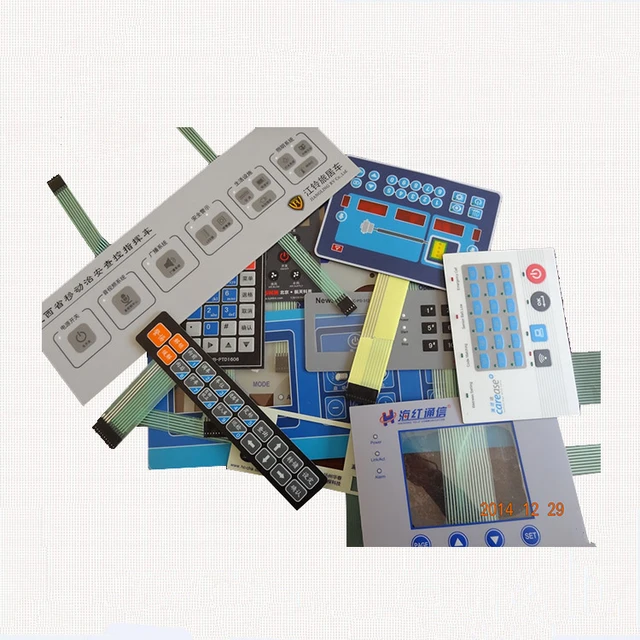Top Features to Look for in a High-Quality Membrane Switch
Top Features to Look for in a High-Quality Membrane Switch
Blog Article
Comprehending Membrane Switches Over: The Trick to Dependable and sturdy Controls

What Are Membrane Buttons?
Membrane layer buttons are an advanced solution in the world of customer interface innovation, integrating performance and design flawlessly. These devices serve as an interface in between customers and electronic systems, integrating a number of parts right into a compact format. Typically constructed from adaptable, slim layers of products, membrane buttons are developed to react to touch, making it possible for customers to interact with equipment and digital tools successfully.
The key aspects of a membrane layer switch consist of a printed circuit layer, visuals overlay, and a spacer layer that protects against unplanned activation. The visuals overlay can be customized to show brand identification or user choices, enhancing looks while making sure usability. Membrane layer switches are frequently used in various applications, consisting of clinical tools, consumer electronics, and commercial tools, owing to their durability and resistance to environmental elements such as dampness and dust.
Among the key benefits of membrane switches is their capability to stand up to wear and tear, making them ideal for high-traffic settings. Furthermore, they are light-weight and call for marginal room, enabling ingenious styles in item advancement. Generally, membrane layer changes represent a practical and reliable option for modern electronic user interfaces, weding innovation with user-centric design principles.
How Membrane Layer Switches Work
The procedure of membrane layer switches over joints on a simple yet reliable device that converts customer input into digital signals. When a user presses the button, the top layer warps, permitting a conductive element in the circuit layer to make call with an equivalent conductive pad on the bottom of the graphic overlay.
The layout of membrane layer buttons can differ, yet they typically incorporate domes or tactile elements to supply feedback to the individual, boosting the general experience - membrane switch. The products utilized in membrane switches, such as polyester or polycarbonate, contribute to their sturdiness and resistance to environmental factors, consisting of wetness and dust. Additionally, the printed circuits are commonly encapsulated, which protects them from wear and tear gradually.
Benefits of Membrane Switches

Additionally, membrane layer switches are recognized for their longevity. Built from robust materials, they are immune to dirt, wetness, and physical wear, which significantly extends their lifespan compared to conventional mechanical buttons. This resilience makes them especially suitable for high-traffic atmospheres and applications requiring durability.
Another substantial benefit is the convenience of cleansing and maintenance. The smooth surface of membrane switches minimizes dirt accumulation and is frequently Full Report invulnerable to spills, making them perfect for setups that need regular sanitization.
Moreover, membrane buttons supply a streamlined profile, bring about a thinner layout that can be integrated right into various gadgets without including mass. This attribute not only improves the aesthetic appeal yet also adds to a more ergonomic product style.
Applications of Membrane Layer Buttons
Easy to use and flexible, membrane buttons find applications across a large range of industries, including clinical tools, consumer electronics, and industrial tools. In the clinical area, these buttons are integral to devices such as analysis devices, person monitoring systems, and infusion pumps, where dependability and ease of cleansing are critical. Their capacity to stand up to harsh atmospheres and preserve performance makes them optimal for such applications.

In consumer electronic devices, membrane layer buttons are made use of in products like microwaves, cleaning devices, and remote controls - membrane switch. Their streamlined layout permits instinctive individual interfaces, enhancing the total user experience while giving toughness and resistance to use and tear
Industrial tools likewise gains from membrane layer buttons, especially in control panels for machinery and automation systems. These switches supply protection against dirt and dampness, making sure regular performance in challenging settings. Moreover, their customizable features allow producers to tailor them to details functional needs, improving efficiency and functionality.
Choosing the Right Membrane Layer Switch Over
When choosing a membrane layer button, it is vital to consider numerous aspects that affect performance and viability for specific applications. The main considerations include ecological problems, tactile responses, resilience, and design requirements.
First, evaluate the operating atmosphere; switches exposed to wetness, chemicals, or severe temperature levels need details materials to guarantee longevity and performance. Next off, examine the demand for responsive comments. Depending on user communication, some applications may take advantage of a responsive feedback to validate activation, while others might favor a non-tactile layout for visual reasons.
Sturdiness is one more important element; membrane switches must be created to withstand regular usage, influences, and abrasion. check out this site Make certain the picked switch can withstand the anticipated lifecycle, particularly in high-usage circumstances.
Verdict
In conclusion, membrane layer switches over work as important parts in the layout of reputable and resilient control systems across various markets. Their portable style, incorporated with robust building and construction and personalized attributes, enhances customer interaction while making sure long life in demanding atmospheres. The adaptability of membrane switches permits customized services that fulfill specific operational needs, strengthening their importance in modern-day technology. As markets remain to develop, the significance of incorporating reliable membrane layer button remedies can not be overemphasized.
Membrane layer switches over stand for a link critical facet of modern interface layout, blending performance with durability in various applications.Membrane layer switches are an advanced solution in the realm of user interface technology, incorporating capability and design flawlessly. Usually created from adaptable, thin layers of materials, membrane layer switches are designed to respond to touch, allowing individuals to interact with equipment and digital gadgets properly.
The layout of membrane layer switches can differ, but they often integrate domes or tactile components to provide responses to the individual, enhancing the general experience.In final thought, membrane layer switches over offer as crucial components in the design of reliable and sturdy control systems across numerous markets.
Report this page